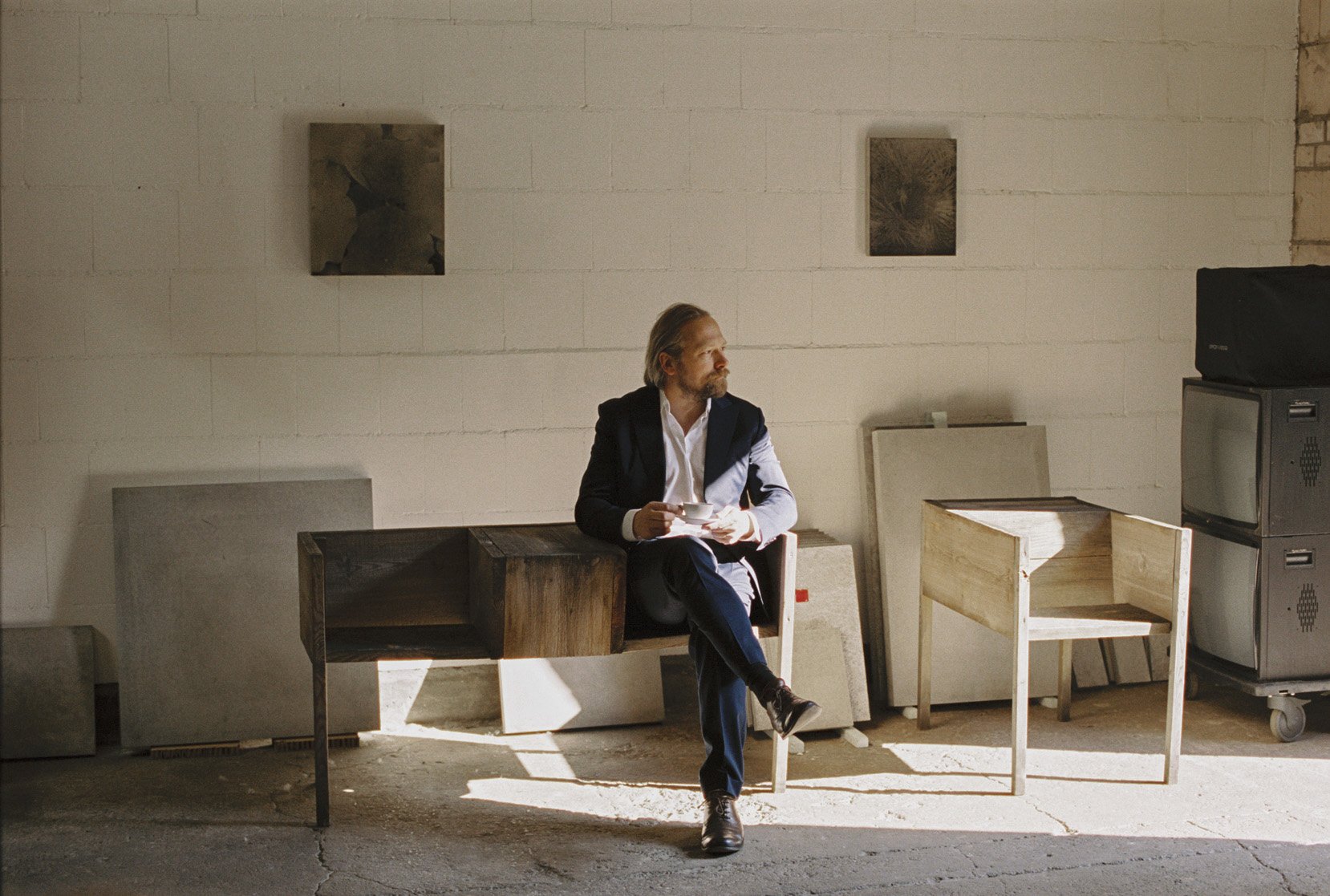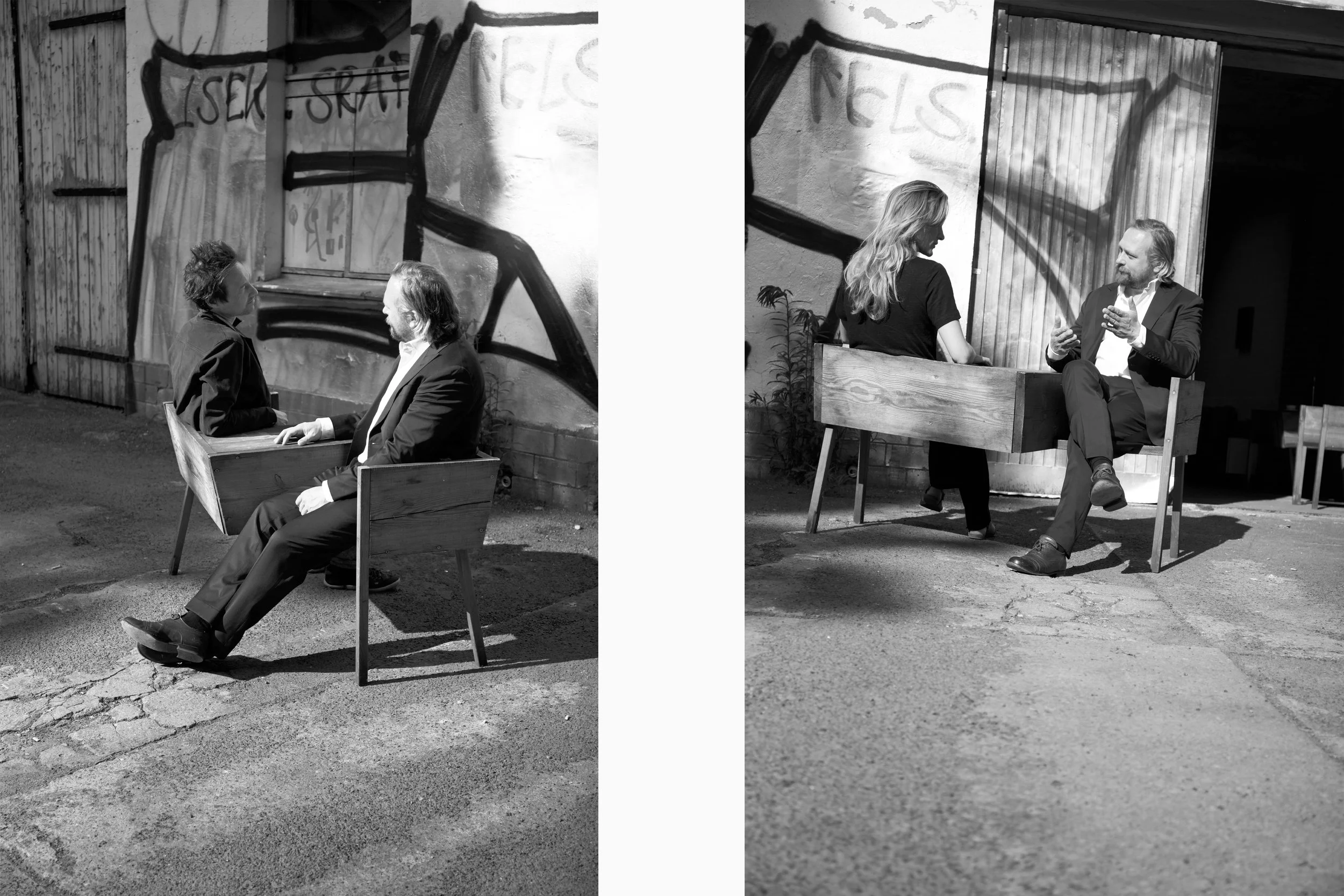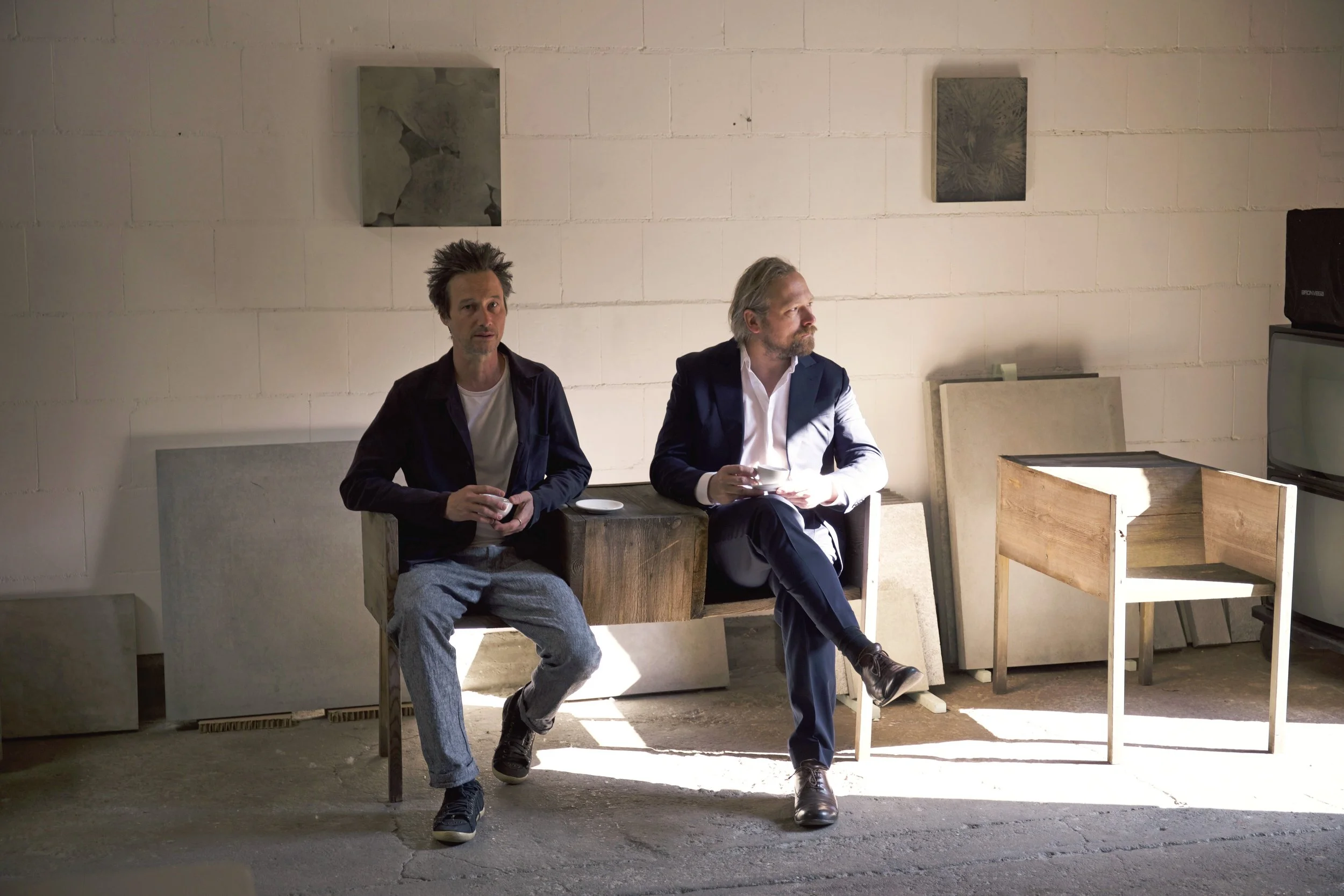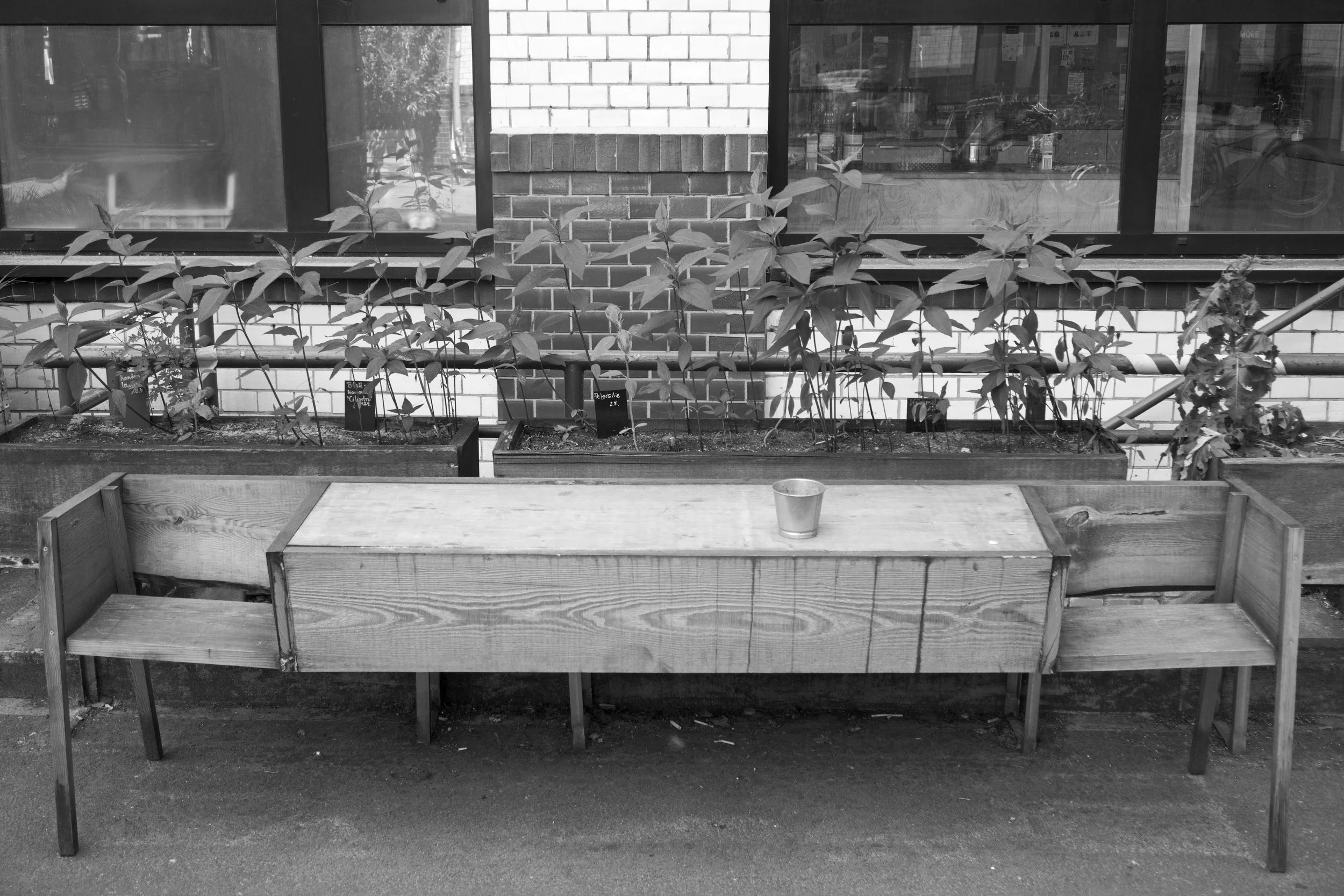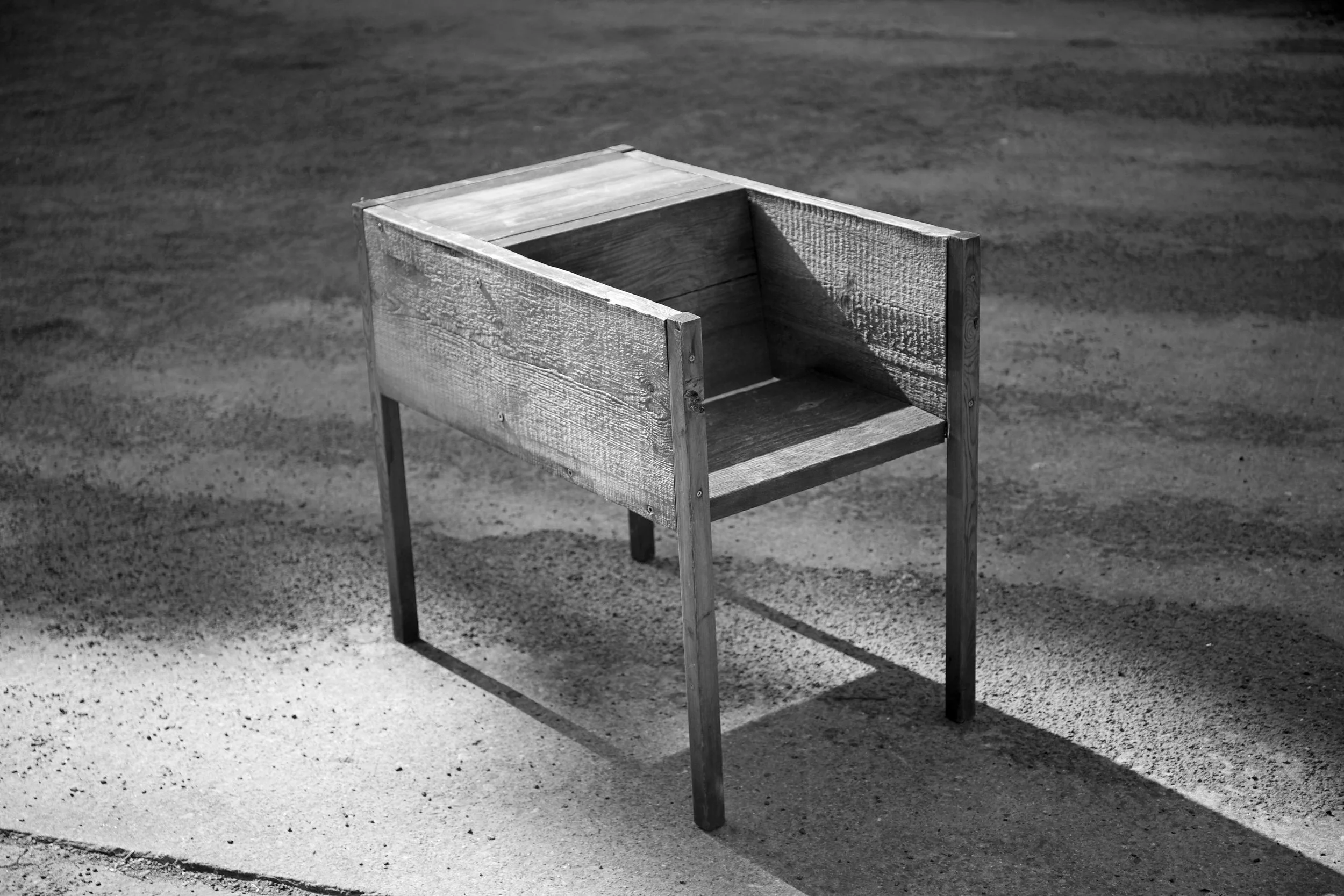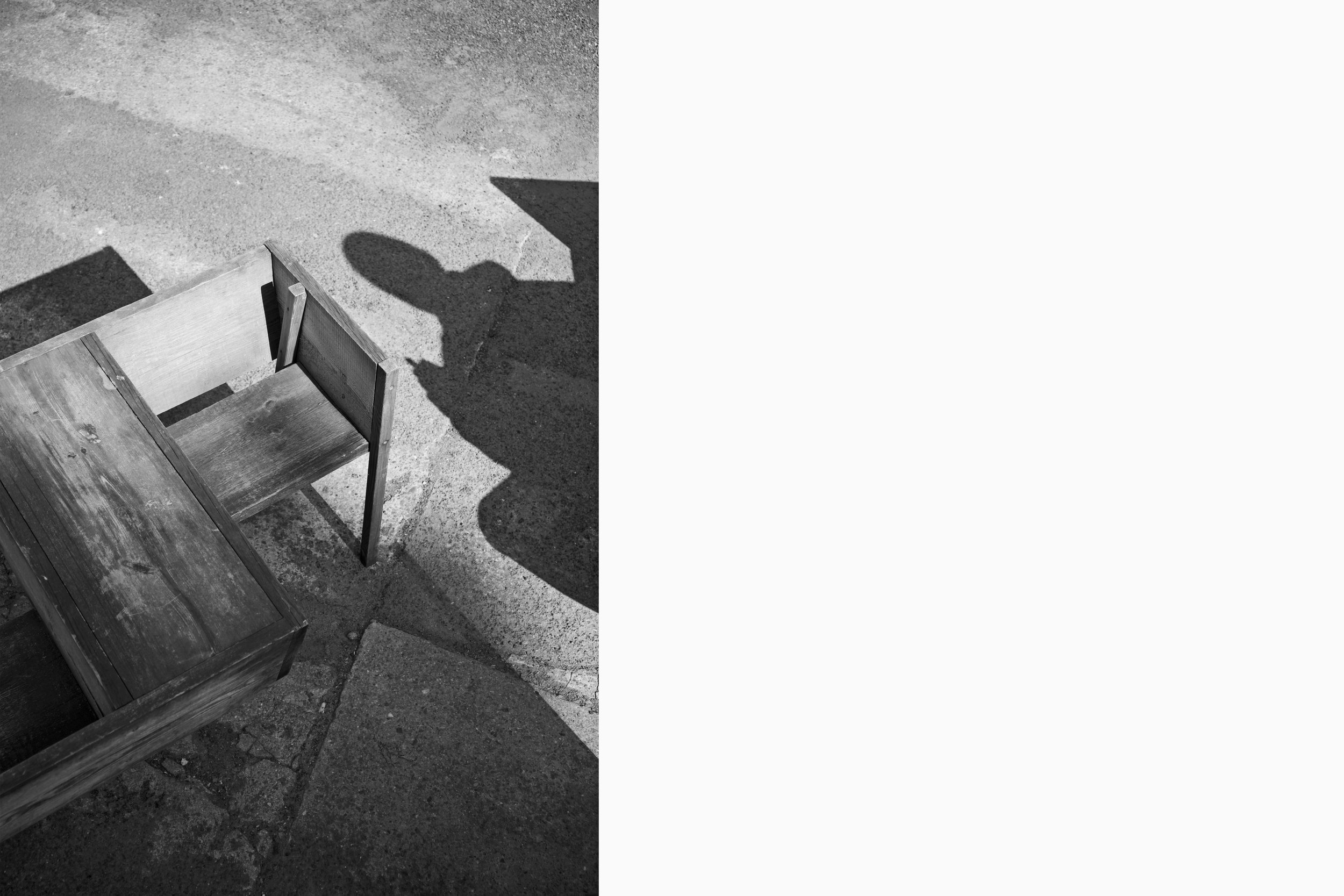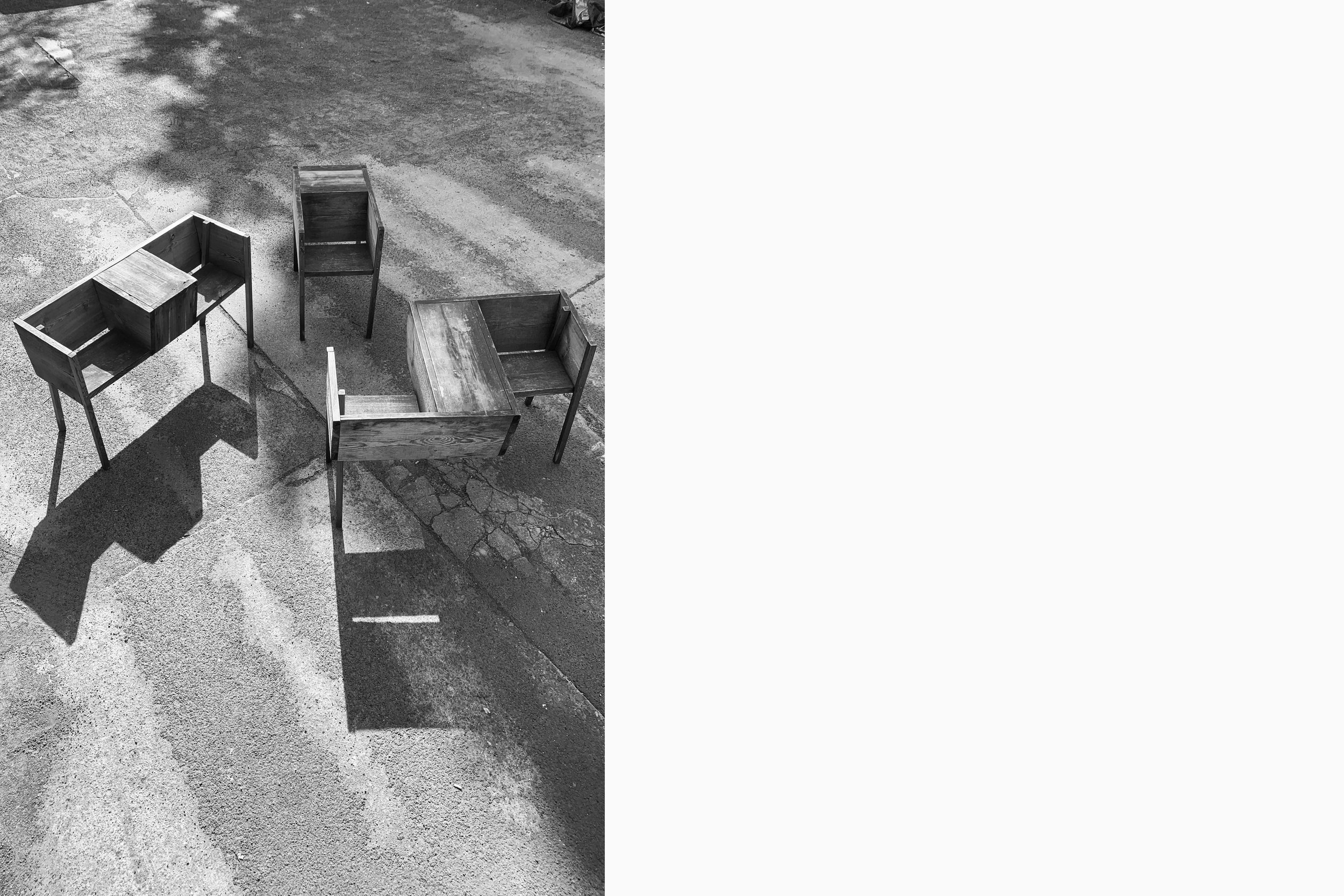Furniture and the art of conversation
July 24 • interview with the artist Mirko Mielke • written by Timo
We met artist Mirko Mielke in his studio in Berlin for a conversation. In his design and photographic work, he explores the way images, furniture, or buildings shape the way we experience the world. This sensitive relationship of his artworks to their immediate surroundings is especially interesting to us at hidden strategy.
Today we talk about his series of communication furniture. Mielke has experimented with different variations of chairs for two people that provoke different kinds of communication. The question is how physical furniture can influence or change conversations. And how all this may change in a digital world.
Some of his furniture pieces are in the studio. Bolted together from untreated wood, they seem a little uncomfortable, almost conceptual, but their unpretentious nature makes them also very inviting. Around us there are numerous chunky forms and panels of concrete, leaning on the walls in various sizes. Here Mielke develops photographs directly on concrete. Most of them are studies of the built environment and nature. In his art, images of plants, furniture or architecture become material objects of communication. He also works directly on objects and buildings in the urban context.
TP Good morning, I am very pleased that we are doing an interview together. We were fascinated by your furniture project that creates different spaces for conversations.
But before we get into this project maybe you could briefly say a few sentences about yourself. What particularly fascinates you about your work? Are you a designer or an artist?
MM I was hoping you could give me the answer to that. I think the framework for my work is design. Originally, I come from photography, and there in the broader sense from experimental photography, that is, with a playful approach, both technically and materially. For example, I work with photography directly on concrete. What has always interested me is to work between the disciplines, for example, to find a space between photography and architecture in which to work and communicate.
This communication is very important for me. When you make a work of art, the direct engagement of the viewer with the work is usually missing. In my own exhibitions, I have observed this very closely. And in the end, this sparked the idea for the furniture series.
The moment you design a piece of furniture where two people can be together, you already have this direct confrontation. That's what it's all about for me when I create a work of art. What happens inside the person who uses it? That was the beauty of this series of, let's call it, "communication furniture". I don't know if it should be called "art furniture"?
When I was asked what I could design, I had the simple thought: there are thousands of chairs, but only a few that you can sit as two people. I wanted to explore this theme, not so much in terms of precise craftsmanship, but more in a sketchy way, to see what happens to the conversation when two people sit together in different ways.
TP Then let's dive in. Could you briefly describe how the first collection of communication furniture came about?
MM It was created in a workshop at the Vitra Campus in Boisbuchet at the invitation of the Zurich University of the Arts. There I made the first collection out of building planks and wooden canes for tomatoes.
I started with a classic "causeuse", a double seater or small sofa for two people. Originally it comes from a courtly context, so in a way it stood for a separation from the people.
But for me it is about connection, the invitation to come together in one piece of furniture. A double seater is actually saying, "Sit in here two at a time!" The first design had this inviting character.
My aim was to explore different possibilities of conversation in the sketchiness of quickly assembled furniture. This led to La Causeuse, Le Confidant, Le Solitaire and Le Dos-à-Dos.
TP How did these different variations come about. And what do they look like?
MM The inspiration for the variants ultimately came from an experiment with intimacy. We started with a four-metre-long untreated building plank and came closer step by step. I think, there are seven layers of intimacy. It's about the emotional question of where the distance is too great for me or where the closeness is too close.
The first variant was La Causeuse. In this design you sit opposite each other in a slightly displaced position. I think that's a very pleasant way of having a conversation. And by sitting together in a single piece of furniture, you adopt a different attitude towards yourself, and towards the other person. You only have these four legs under you, together. That was the first idea.
A derivative of this is Le Parisienne where you sit next to each other and look in one direction. This variation also came about because the gallery I created it for had two beautiful large window fronts. It fitted in wonderfully, like in Paris, with two chairs and a small table between them, looking out onto the boulevard.
TP Would you go so far as to say that the way you sit together in the furniture also influences the way you talk?
MM Yes. When you look together in one direction and see what is happening - you look at everyday life, the flow of the street - then you relate to the conversation differently. When you sit opposite each other, you are more concentrated and more together.
But there were other variants of conversation, Le Confidant for example. You sit at a slight angle, back-to-back, not facing each other, but away from each other. That means your heads are very close together, but you can't see each other. This allows you to have a conversation that you might not have if you could look each other in the eye. For many, it reminded them of a confessional. Some found it too intimate.
This uncomfortable intimacy became even more evident in Le Dos-à-Dos. That is a chair that has no backrest. Like on the beach, you sit here directly and literally back-to-back against each other and with each other. Le Dos-à-Dos was part of the first series. It was interesting to see, whenever I exhibited it, that for many it was far too intimate to sit back-to-back with a stranger. I guess this direct contact presupposes a certain closeness to each other.
TP You talked about different levels of intimacy. Where does intimacy begin, where does it end?
MM I think everyone finds that out for themselves. And I think that intimacy can be understood quite differently in other cultures, for example when you are out in public. I’m thinking of that feeling of standing at the cash register and sensing someone behind you. This can be uncomfortable. It’s not always about sitting opposite each other.
Everyone senses this closeness, or rather these boundaries, for themselves and yet also for the other person. That's what I wanted to experiment with, that's what I wanted to find out with this furniture series.
And that's why there are the two individual chairs, Le Solitaire and Le Secretaire. With these you can decide the proximity yourself and there is more variance. I would say that the role that a single chair takes on in an overall setting of different seating possibilities is interesting.
TP Are you saying that the furniture has a very different effect when it is placed together in different settings?
MM Absolutely. This also becomes evident in the second series, which is an evolution of the first. Here the idea was that sometimes you need a table to put something, like a glass. With La Causeuse Plus, for example, you are now more or less separated by a small table, or rather a table is integrated into the conversation situation.
TP So in the second series a table separates the two seats. Doesn’t that bring a distance into the communication?
MM Yes, a distance came in. During the Covid-19 pandemic, I even expanded this distance into a social distance version for an outdoor cafe. The question was, how far is 1.5 m, the officially defined measure of social distance? How far away am I from you then? How does that feel? It was, if you like, the inversion of the basic idea that you sit together. Somehow it worked well because you couldn't be close, but you could still spend time together in a safe way.
The Corona version of Le Secretaire was also well received. It was meant to be inclusive. So in the social distance version you could also join people in wheelchairs, for example.
But really, the second series was less about distance and more about expanding the possibilities. How can you increase the quality of stay through a table, so that it's not just the conversation you're in? I think this also creates a different proximity.
The first series was primarily about the fact that when people are together in one piece of furniture, they take on a different attitude towards each other and themselves. The conversation is then of different durations depending on who is there and with whom. In the second series, the idea was to increase the quality of the stay with this additional table, and to create a space to have breakfast together, for example, or to drink an aperitif. Le Parisienne emerged from an elevation of this idea; two chairs and a table between them looking out onto the boulevard.
In contrast, with the single chairs and table, I have come to a bit of a dead end in terms of design. Here you have a table in your back, which is actually pointless. It's like a Le Dos-à-Dos, except that the second back is now a table, or a stage. You could climb on it and dance, that was another idea.
Finally, it led to the Le Ordinaire Plus, which is a normal bench where two people sit, with a table in their back: a piece of dance furniture with a small stage on which you can perform.
TP The table theme reminds me of another project of yours, I think it was called the outdoor counter or the social bar?
MM Yes, the outdoor counter. That was an attempt to sculpt the public space and create a quality of stay by adding additional objects. The first of these objects was for a street corner, where you could now stand in two and have, I’d say, a certain new attitude. I have done the same for electricity boxes and streetlamps. All of these objects, or rather tables are made of concrete.
TP How did that work? Did you get to install the objects for a few days? Or are they integrated into the outdoor space forever?
MM They were permanent. And one concrete addition to an electricity box still exists. It was an attempt to use a minimal object to create a function in a space where there really is none.
Based on this project, I also experimented with filling a table of a La Causeuse Plus with concrete. This made it correspondingly heavier, an immovable permanent element of the outdoor space. It was interesting because here the furniture, and the conversation, was constantly overwritten by people who stayed there and often added something to it. Like carving something into a tree. It became a project of social aging: designed by those who use it.
Unfortunately, it was stolen from outside my studio at some point.
TP It seems like people were using the La Causeuse Plus in front of your studio just as any other street furniture. How do people generally engage with your pieces of furniture? Do they see them more as works of art or as commodities?
MM I probably didn't understand Beuys' term ‘social sculpture’ correctly, but “pure design”? That's not what the chairs are. Does that make them art? I don't know. But I would like to see them as objects that invite people to talk to each other.
Many people have accepted the furniture with this absolute matter-of-factness, as if they had always been there. Some people were also a little bothered by the fact that they are not finely handcrafted. I wanted to let simplicity speak, to design the space with a physically graphic work. Once at a design exhibition I got the feedback: “worst craftsmanship”, or something like that. I think the journalist just had a quick look at the chairs online.
TP What is the journalist missing when he looks at the chairs on the internet?
MM I think the experience of having sat in them, of having had a conversation. It's not about comfort, I think the luxury is, in this case, the Spartan in the real sense, that you adopt an attitude, towards yourself and towards the other, at the very moment you use the furniture. As a pure object of contemplation, it would probably work better as a drawing.
But with this furniture series, it's less about the object and more about sitting in it and talking. This gives you different levels of looking, different communications, and an understanding that might not have happened otherwise. I was never interested in a material elaboration, I wanted to develop the conversation further. What other forms of communication are there? For example, you can also sit three to a piece of furniture. That would be Le Ménage à Trois. It hasn't been built yet, but it has been conceived.
TP You just mentioned the internet. Is there also a variant for a conversation via smartphone?
MM For this, of course, there is Le Secretaire. A single chair with a classic telephone table on the side. Here you can be with yourself and the person on the phone. The idea was that you can consciously withdraw or physically separate when you are in a communication on the phone.
TP That sounds more like a traditional telephone conversation. Do you think there is perfect furniture for a digitalised world? Do you have any ideas?
MM Yes, I once designed a piece of portrait furniture. (editor's note: digs out a sketch). You sit there in two, one draws, the other is portrayed. I don't know if you could pimp it in a digital way to communicate, but that would be an idea.
TP Do you mean like interacting with a screen?
MM Yes, exactly. I had also thought of putting a projector in the middle table of Le Parisienne. Two people would look at the same image, just like on a Parisian Boulevard. On the other hand, with La Causeuse Plus you could look at two different projections. I would like to understand if this could lead to different kinds of conversations.
TP I'm fascinated by all these experiments. What do you think about chairs for conversations in a digital world? Do we still need them, or are they reserved for a certain art scene? What is your vision here?
MM Well, I would like to try that out. I think only then I can judge it.
TP Thank you very much for the conversation.
all photos by Tor Harrison and Timothy Pape

